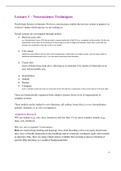Resumen
Summary Introduction to Neuroscience: LECTURE MATERIAL (Grade: 9.5)
- Grado
- Institución
My summary got me a 9.5 on the Intro to Neuroscience exam, as part of the Brain and Cognition Specialization. By studying with my notes, you won't need to consult the lectures. I include screenshots of the slides, plenty of images alongside concepts for better understanding, and many examples that...
[Mostrar más]



